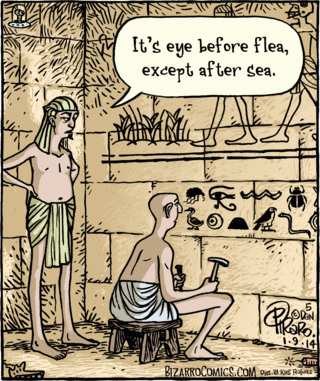For this week's essay assignment, I decided to write over English spelling and it's many rules. In the cartoon below there is a rule that many of us have become familiar with as we learned to spell in grade school. I can say, for myself, that I use this rule often whenever the vowels "e" and "i" must be put together. When reviewing the article related to this assignment I did not realize that the rule "i before e, Expect after C" also has another two lines to it that will expand on this writing skill (which is noted below).
i before e,
Except after c,
Or when sounded as "a,"
As in neighbour and weigh.
(Wikipedia)
Except after c,
Or when sounded as "a,"
As in neighbour and weigh.
(Wikipedia)
I like this cartoon, and find it funny, because that it symbolizes how long the rule has been used. Since not all languages use our alphabet, the way the rule is used in this cartoon also gives it a comical twist. Egyptians obviously used hieroglyphs for reading and writing processes. Since hieroglyphs were symbols representing entire words, or ideas, this rule would not have been applicable to them since it only applies to the English alphabet.
When trying to look back, this is the only spelling rule that comes to the front of my mind. I decided to Google search the most common spelling rules, which we use daily, and may not realize. My first search revealed a website which contains information regarding the top four spelling rules. The first rule, funny enough, is the rule that is regarded in the cartoon. The next rule is over dropping the final "e" before a suffix that begins with a vowel, but not before a suffix that starts with a consonant. For example: ride+ing= riding or like+ness= likeness. The third talks about converting a word that ends in "y," and changing this to an "i" before a suffix, unless the suffix itself begins with an "i" already. Examples include: defy+ance= defiance or occupy+ing = occupying. The fourth, and final, rule is probably one that I find the most difficult at times. This rule is about doubling final consonants in words. There are two parts of this rule, "(a) a single vowel precedes the consonant; (b) the consonant ends an accented syllable or a one-syllable word." Examples are as follow: stop+ing= stopping or benefit+ed= benefited.
As I was researching for this essay, I began to realize just how complex the English language really is. I can see why if one was not brought up speaking, and more particularly writing, in English then it can be extremely difficult to learn. Above I have listed four basic rules regarding English spelling, but it seems that there are exceptions to every rule which just adds to the complexity.
If you are more interested on the spelling rule that is depicted in the picture, and was introduced first in this essay, you can enlighten yourself here.
For information regarding the website that contained information over the three other rules mentioned, the link for the website can be found here.
For information regarding the website that contained information over the three other rules mentioned, the link for the website can be found here.

I am and always have been a horrible speller. Things like this have always helped me! I was really confused as to what cartoon you were talking about at the beginning until I saw the image down a the bottom of your page. Maybe put the picture at the beginning of the essay if you are going to talk about it immediately? Just so that people aren't confused while reading your essay. Other than that I really like your point of view on how the English language is so difficult because of these little rules. One of my very best friends is not a native English speaker, but he has been speaking it since he was young. Even though he has been speaking it for so long, he still gets words and punctuation wrong constantly.
ReplyDelete